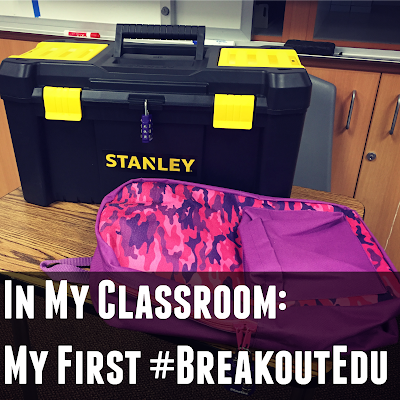In the Classroom: My First BreakoutEdu
When I started this year a colleague of mine was obsessed with #BreakoutEdu and she kept building these incredibly intricate lessons and showing pictures of students highly engaged in their work. During first semester, I had dipped my toe in the water by making a scavenger hunt that had some locked google forms that students had to open to get the next clue but they were mostly review questions and did not have the same elements of a true breakout.
 I knew I wanted to do something big to bring up morale and energy when students returned from Spring Break and I also wanted a lesson that was a mix of review and new information, to get students back into World War II after a week away. So I created by first Breakout lesson and it was amazing.
I knew I wanted to do something big to bring up morale and energy when students returned from Spring Break and I also wanted a lesson that was a mix of review and new information, to get students back into World War II after a week away. So I created by first Breakout lesson and it was amazing. What is BreakoutEdu?
Well, it's kind of like an escape room for your classroom but instead of having students locked in a room and trying to break out of it, they are trying to break into a series of bags and boxes that each have combination locks. The clues provided for the locks are where the educational part of this lesson kicks in, you can literally create a breakout for anything. To open each lock you create a series of clues or puzzles students must solve in order to get the combination.
How did I set it up?
Originally BreakoutEdu was designed to have physical locks for students to open and it is easy to see the value in having a tangible item for students to unlock. It creates a hook; a new and different kind of challenge. I also know for my classroom a lesson would work best with ten teams of four students and I had a hard time with the idea of buying 60 locks to make 10 different kits.
 So, I mixed the concept of a digital breakout and a physical breakout. This allowed students to complete the puzzles and clues with their teams and still had the hook of having two physical locks each group had to get through. One was a backpack and that held 10 envelopes of clues (one per group) and the second was the final toolbox. If they got in the tool box, they "broke out" and got to celebrate with silly hats, noise makers, a photo op, and balloons. All other "locks" were on Google Forms with data validation so students had to get the right combinations before it would allow them to submit and give them the next clue.
So, I mixed the concept of a digital breakout and a physical breakout. This allowed students to complete the puzzles and clues with their teams and still had the hook of having two physical locks each group had to get through. One was a backpack and that held 10 envelopes of clues (one per group) and the second was the final toolbox. If they got in the tool box, they "broke out" and got to celebrate with silly hats, noise makers, a photo op, and balloons. All other "locks" were on Google Forms with data validation so students had to get the right combinations before it would allow them to submit and give them the next clue.
What did my students think?
I graded students that day on their reflection from the activity and then their exit ticket was an Answer Garden poll where they were asked to describe the activity in three words. I exported the Answer Garden results to a word cloud generator to help me visually see what most students thought of the experience.
Not every word is positive on here but the three largest words and the ones that were repeated the most in the survey were fun, interesting, and challenge. The majority of my students found the lesson challenging, exciting, fun and it kept their interest. This was clear to me as I walked around the room and while some shouted "THIS IS SO FRUSTRATING!" they all still returned to the challenge in front of them with a smile on their face.
I did my first Breakout with my sophomore classes and plan to try it with my seniors in a few weeks. I'll be sure to update on how it went with a different age group but for now, have you done a Breakout? What did you like about it? What was challenging for you?
Have a Great Day!
Mrs. Kathryn Byars





Comments
Post a Comment
Thank you so much for commenting! You can also reach out to me on twitter: @mrsbyarshistory